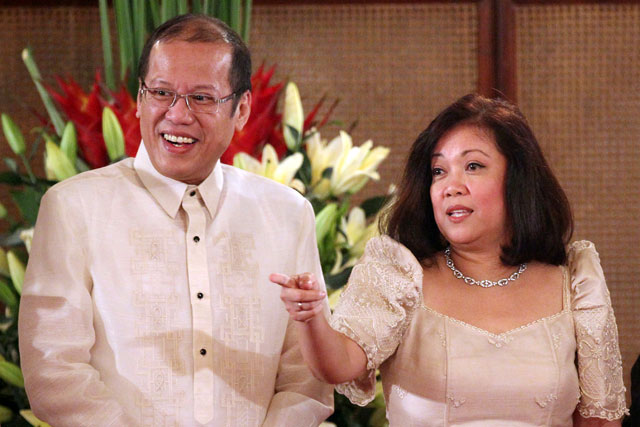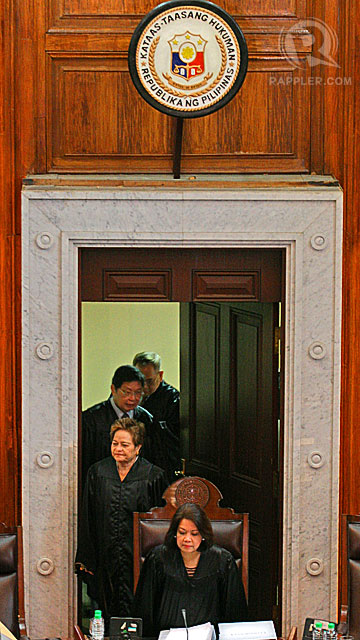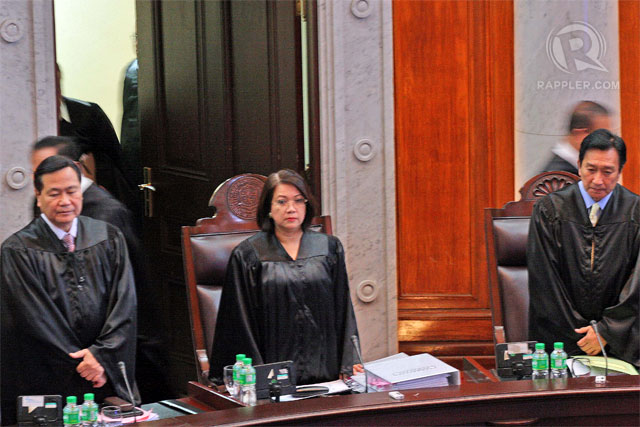SUMMARY
This is AI generated summarization, which may have errors. For context, always refer to the full article.

MANILA, Philippines – Chief Justice Maria Lourdes Sereno is, in the words of retired Chief Justice Artemio Panganiban, “both an insider and outsider.” Sereno, who took her oath as chief justice on August 25, 2012, had enough time “to know the internal dynamics, habits and processes of the Supreme Court,” Panganiban said in a speech last year. Sereno, after all, served for two years as an associate justice before taking on the highest post in the judiciary.
But she is also an outsider, given her short time in the SC, which would work to her advantage, Panganiban added. She could “see afresh the judiciary, think outside the box and transform the courts without being tied to past practices and traditions.”
As it turns out, this was a double-edged sword.
One year into her term as chief justice, Sereno, the first junior justice to be appointed to lead the Court, is continuing earlier reforms in the institution, but it is far from easy. The pace has been slow as she wades through difficult terrain in the hierarchy-steeped Court, meeting up with strong resistance from some of her colleagues.
READ: Sereno is first female justice
Decentralization was a priority in Sereno’s reform agenda. She wanted to restore the regional court administrator’s office (RCAO), which was launched in 2008, to make operations of the court more efficient. Past chief justices, Reynato Puno and Renato Corona, were not keen on this project as its initial implementation showed problems in the coordination between the central court administrator’s office and RCAO; it also drew opposition from some court employees in Cebu.
But Sereno erred when she unilaterally issued a resolution in November 2012 which ordered the re-opening of RCAO under a new name, the Judiciary Decentralized Office. Justice Teresita de Castro, who has been at odds with Sereno even before the latter became chief justice, issued a memorandum saying that Sereno’s resolution did not reflect the views of the en banc on the issue. De Castro said the en banc opposed RCAO’s restoration.
To avoid an impasse, the en banc decided to establish a committee that will study the re-opening of RCAO. The project is on hold.
Other reforms appear to proceeding smoothly.
Under Sereno’s watch, the SC launched the electronic Court (eCourt) system in June, which records information about cases, from the date they were filed to their status. The assignment of cases is also done electronically. The eCourt is being pilot-tested at the Quezon City regional trial court.
It was also under her term when the judicial affidavit rule – which aims to cut trial time by 50% – was implemented, though it was developed during the time of her predecessor, impeached Chief Justice Corona. The judicial affidavit rule will do away with direct testimonies and instead use affidavits in criminal cases. It was modified, however, after the Prosecutors League of the Philippines and the Department of Justice complained that the judicial affidavit rule would only worsen the delay in the resolution of cases because prosecutors would still have to prepare the affidavits.
Minority CJ?
When it comes to her voting record in high-profile cases, Sereno is often with the minority.
The status quo ante order that the High Court issued in the case of the Senior Citizens’ party-list group in was enmeshed in a backdrop of internal fissure, one that has hounded Sereno since her appointment as chief justice.
Sereno first issued a temporary restraining order stopping Comelec from proclaiming winning party-list groups in May.
READ: SC reverses Comelec on Senior Citizens party-list
Reports said that Justice De Castro, however, only wanted the TRO to cover the Senior Citizens party-list group and not other groups that also sought remedy from the Court after they were disqualified by the poll body.
In a letter to Sereno, De Castro said that issuing a blanket TRO would “be deemed as an overbroad restriction on the constitutional authority of the Comelec to proclaim winners in the party-list elections.”
In Maliksi v. Saquilayan, Sereno was in the minority. The SC, voting 8-7 in April 2013, initially upheld the Comelec decision declaring Homer Saquilayan as the rightful winner in the 2010 mayoralty elections in Imus, Cavite.
The poll body said Saquilayan beat Maliksi by 8,429 votes. Maliksi got 40,092 votes while Saquilayan got 48,521 votes.
The SC changed its vote, however and granted the motion for reconsideration filed by Saquilayan’s rival, Emmanuel Maliksi, Aquino’s party-mate in the Liberal party. In the final decision, Sereno voted with the minority.
READ: SC flip-flops; Maliksi still mayor
In Atong Paglaum v. Comelec, Sereno also voted with the minority where the SC said not only marginalized sectors could participate in the party-list system. The ruling paves the way for national and regional political parties and organizations to register under the party-list system and seek seats in Congress as long as they do not field candidates in legislative district elections.
READ: SC shakes up party list in new verdict
The decision widened the playing field for groups that aimed to participate in the party-list elections, but organizations representing marginalized sectors said it put them at a disadvantage.
Voting with the minority, Sereno said the decision “may have further marginalized the already marginalized and underrepresented of this country. In the guise of political plurality, it allows national and regional parties or organizations to invade what is and should be constitutionally and statutorily protected space.”
Sereno was in the minority as well when the SC ruled against San Roque Power Corp in its claim for a P560-million tax refund. The SC said the corporation should have waited for the Bureau of Internal Revenue to first decide on the firm’s demand for a tax refund before going to the Court of Tax Appeals in 2003. The High Court voted 9-4, with Sereno dissenting with Justices Presbitero Velasco Jr., Jose Mendoza and Estela Perlas-Bernabe.
Being part of the minority is not new for Sereno – she is a known dissenter, her opinions laced with frank and strong language.
READ: Justice Sereno: Defying tradition
But that was when she was a junior magistrate. Now that she is chief justice, even if she only has one vote, as primus inter pares (first among equals), she’s expected to hold sway over the court and establish near-consensus.
No predictability yet
A paramount measure of the Court’s unity is the quality of its decisions.
Sereno took on the High Court’s headship when it was reeling from criticisms that its decisions lacked predictability and were heavily influenced by politics.
Under the time of Chief Justice Reynato Puno from 2007-2010, up until Corona’s short-lived leadership, the SC flip-flopped on various cases – it changed its decision in the case of League of Cities of the Philippines v. Comelec thrice, where it initially ruled that the laws converting 16 towns into cities were unconstitutional.
READ: League of Cities finally recognizes 16 ‘unqualified’ cities
 The SC also reversed its decision on the constitutionality of declaring Dinagat islands as a province. In another case, it made a turnaround when it exempted the judiciary from the appointment ban in 2010, something it chastised the executive for in 1998 in De Castro v. JBC.
The SC also reversed its decision on the constitutionality of declaring Dinagat islands as a province. In another case, it made a turnaround when it exempted the judiciary from the appointment ban in 2010, something it chastised the executive for in 1998 in De Castro v. JBC.
The Sereno court has its own share of flip-flops: in Maliksi v. Saquilayan, the SC, voting 8-7, initially declared Homer Saquilayan as the rightful winner in the 2010 mayoralty elections in Imus, Cavite. This was in March.
A month later, it changed its vote and granted the motion for reconsideration filed by Saquilayan’s rival, Emmanuel Maliksi, who belongs to the Liberal party.
The SC also allowed the live coverage of the Ampatuan trial but reversed itself and granted the motion for reconsideration filed by Andal Ampatuan Jr., one of the main suspects in the killing of about 58 people in Maguindanao in 2009.
READ: SC flip-flops: No more live broadcast of Ampatuan trial
One case that does not involve flip-flopping but which cast a shadow on the integrity of the Sereno court involved Justice Velasco’s son, Allan, who lost to Regina Reyes in the 2013 elections. Reyes defeated the younger Velasco for the post of representative of the lone district of Marinduque.
Velasco questioned her citizenship before Comelec, which ruled in his favor. Comelec said Reyes should be disqualified because she is an American citizen and has failed to meet the one-year residency requirement for candidates. Reyes elevated the case to the High Court – which acted immediately, voting 7-4-3 in favor of Comelec; Sereno was with the majority.
READ: Marinduque rep threatens to impeach Velasco
Critics said the SC lacked jurisdiction over the case, as it should have been resolved by the House of Representatives Electoral Tribunal and not by the High Court.
Sereno’s vote favoring Allan was seen as her way of strengthening her ties with his father and have him as an ally amid the infighting in the SC.
READ: Dark clouds in the Supreme Court
Majority vote
The SC was not as split, however, in its decision invalidating the 2009 conferment of the National Artist Award to comic strip artist and filmmaker Carlo J. Caparas, fashion designer Jose “Pitoy” Moreno, theater artist Cecile Guidote-Alvarez and architect Francisco Mañosa. The SC voted 12-1.
The SC also voted 13-2 when it upheld the constitutionality of the joint panel of the Department of Justice and the Comelec which filed a case of electoral sabotage against former President Arroyo.
The High Court has yet to decide on a slew of major cases.
It will be interesting to see if Sereno will be in the minority when the SC votes on the constitutionality of the following: a. authority of the Department of Justice to issue hold departure orders b. Republic Act 10175 or the Cybercrime law c. Republic Act 10354 or the Responsible Parenthood and Reproductive Health Act of 2012 d. Republic Act 9742 or the Mining Act of 1995
These would also show how Sereno, Aquino’s first appointee in the High Tribunal, will vote on cases that would impact the Aquino administration.
But one case has become urgent in the light of the multi-billion pork barrel scandal that has shocked and angered the public—and Sereno is the justice assigned to the case. She inherited it in 2010 when she was appointed to the Court.
The Malampaya fund case, which has been pending in the SC for 7 years, involves billions of revenues from the Malampaya natural gas field in Palawan, P900 million of which allegedly went to a fake NGOs linked to Janet Lim-Napoles. The law provides a 60-40 revenue sharing between the national government and Palawan in Malampaya, but Palawan’s share is now the subject of the case. Petitioners headed by Puerto Princesa Bishop Pedro Dulay Arigo pressed the SC to act on the case following the emergence of reports on the pork barrel scam.
Dulay and other petitioners have sought the abolition of Executive Order 386, which was issued by President Arroyo in 2008. The order allowed the use of revenues from Malampaya for development projects in Palawan.
Seniority and squabbling
Sereno had to fight fires early in her term as her bypassed more senior justices like De Castro, Carpio, Roberto Abad, Arturo Brion and Presbitero Velasco. The four have been appointed to the SC prior to Sereno, with Carpio being the most senior as he has been in the Court since 2001. Tradition dictates that seniority should be a prime consideration in choosing the head of the judiciary.

Panganiban wrote in the Inquirer that he understands why the senior justices of the Supreme Court are “disappointed, even dismayed, by the choice of a junior justice as the new chief. For years, they have patiently lined up in faithful observance of the century-old tradition that only the most senior and second most senior are chosen to lead the judiciary. Tradition, seniority and rank are sacred in the judiciary, as they are in the military and in the Church.”
The reports on the tension within the Court ranged from justices not showing up during flag ceremonies to skipping weekly lunches after their en banc meetings. For one, the SC en banc wanted to have the results of the psychological exams of applicants for the post of chief justice released to the respective aspirants following reports that Sereno recorded a low grade of “4.” The psychological exam is a requirement of the Judicial and Bar Council, the body that screens and vets nominees to judicial posts.
When she became the body’s head, Sereno reportedly proposed the removal of psychological tests as a requirement to expedite the selection process of judges and justices.
Lawyer Rene Saguisag though said that this would have to change. “The initial cat fights and intramural have been reduced but as the new kid on the block, the elders should discreetly advise her, instead of showing her up in a shame campaign,” he told Rappler.
The polls show, however, an increase in public approval of Sereno.
According to the June 2013 Pulse Asia performance survey, Sereno’s approval rating increased to 37% from 32% in March. Her predecessor, Corona, enjoyed a slightly higher approval rating at 38% in his first year as chief justice but saw it dip to 14% in March 2012. Sereno’s trust rating also rose to 38% in June from 29% in March.
‘Dignified silence’
As chief justice, Sereno’s first order of the day then was to bring back the SC to days of “dignified silence,” when the justices were heard through their decisions and not through the media.
READ: SC must return to dignified days of silence
While it was lauded by court observers, it caused problems when lack of media access led to confusion in decisions. The Public Information Office, for one, erred in saying that a TRO issued by the SC in a plunder case covers Arroyo.
In 2012, Sereno made UP law professor Theodore Te head of the SC PIO.
READ: Incoming SC spokesman on the Court’s ‘dignified silence’
The SC has now become more accessible. Its website has been revamped to include not only the Court’s financial reports, which were first uploaded when Carpio was acting chief justice, but also audio files of oral arguments. The SC en banc issued new guidelines for the release of their SALNs. Once the requirements for the release of the public document have been met, the justices would approve the release of their respective SALNs.
‘Rookie mistakes’
For Rose Beatrix Cruz-Angeles, former spokeswoman of the Integrated Bar of the Philippines, one of the most important actions of the Sereno court, is the revision of the code of civil procedure. “It’s conceived to shorten the proceedings,” she said.
Angeles added that the Court’s willingness, under Sereno’s leadership, to change its rules is one of its strengths. Hence if one looks at the big picture, Angeles said Sereno’s mishaps do not necessarily show weak leadership: “They are what we call ‘rookie mistakes.’”
If she learns from them, Sereno would be able to do more in the years to come. Sereno is the longest to serve under the 1987 Constitution at 18 years and also the youngest at 52. As Angeles said, “Time is on her side.” – Rappler.com
Add a comment
How does this make you feel?
There are no comments yet. Add your comment to start the conversation.